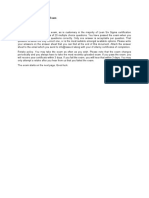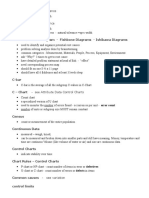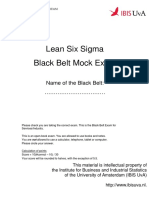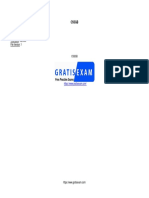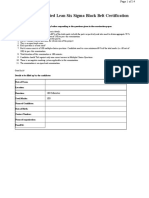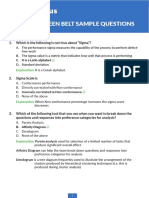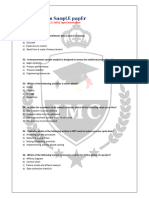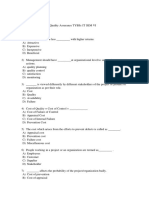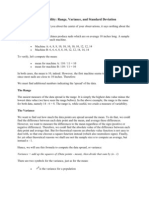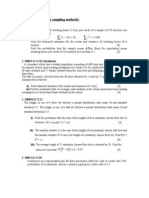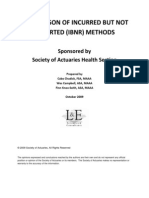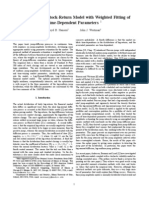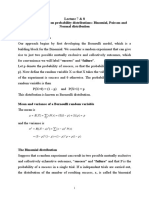Black Belt
Black Belt
Uploaded by
shashankCopyright:
Available Formats
Black Belt
Black Belt
Uploaded by
shashankOriginal Description:
Original Title
Copyright
Available Formats
Share this document
Did you find this document useful?
Is this content inappropriate?
Copyright:
Available Formats
Black Belt
Black Belt
Uploaded by
shashankCopyright:
Available Formats
IselgloBal.
com
InstItute for skIll enhancement and learnIng
01. One characteristic of attributes data is that it is always
a) Continuous
b) Discrete
c) Expensive to collect
d) Read from a scale of measurement
02. A measurement system analysis is designed to assess the statistical properties of?
a) Gage variation
b) Process performance
c) Process stability
d) Engineering tolerances
03. Which of the following activities is value
value-added?
a) Setup
b) Process
c) Storage
d) Inspection
04. In order forr a problem to be solved correctly, which of the following must occur first?
a) The problem must be defined
b) Relevant data must be gathered
c) The measurement system must be validated
d) The process must be mapped
05. Typically, which of the following actions is NOT used to reduce process cycle time?
a) Analyzing current processes
b) Reducing queue times
c) Setting scheduling priorities
d) Implementing activity-based
based costing
06. Which of the following tools is commonly used in the define phase of a pr
project?
oject?
a) Affinity diagram
b) Control chart
c) Failure mode and effects analysis
d) Data collection checklist
07. A tree diagram can be used to do which of the following?
a) Allow a team to identify root causes even when no credible data exist
b) Show a causality relationship
c) Present data from a check sheet
d) Reveal the true level of a problem’s complexity
08. Which of the following is a component of a visual factory?
a) Product specifications
b) Zero defect policies
c) Just-in-time policies
d) Equipment service manuals
IselgloBal.com
InstItute for skIll enhancement and learnIng
09. Which of the following best describes internal failure costs?
a) The economic costs associated with a catastrophic failure of an internal subsystem.
b) The unavoidable quality system costs associated with the production of any pproduct
roduct or service.
c) The opposite of external failure costs.
d) The costs resulting from a nonconformance detected before a product or service is provided.
10. A change agent is responsible for helping the organization do which of the following?
a) Overcome fear of the unknown
b) Reorganize departments
c) Determine performance criteria
d) Identify which group is responsible for failures
11. SWOT is an acronym for:
A. strengths, weaknesses, opportunities, threats
B. statistics without tables
C. sensory Weibull ordinal tools
D. success wields optimal team
12. The leader in the quality movement who recommended that organizations “eliminate numerical
quotas for the work force and numerical goals for management
A. Juran
B. Ishikawa
C. Crosby
D. Feigenbaum
13. The word “champion” in the context of Six Sigma projects refers to:
A. The team that has had the most impact on the bottom line.
B. The
he person who has coordinated teams most effectively
C. The
he individual who has outpaced all oth
others in six sigma knowledge
D. None of the above
14. Customer segmentation refers to:
A. dividing a particular customer into parts that are more easily understood
B. grouping customers by one or more criteria
C. maintaining secure customer listings to minimize communication among them
D. eliminating or “cutting off” customers with poor credit history
15. If DPU = 0.022, the RTU is approximately:
A. 0.022
B. 0.078
C. 0.0022
D. 0.98
IselgloBal.com
InstItute for skIll enhancement and learnIng
16. The operators of a manufacturing cell work out a more orderly arrangement for tool storage
and establish a schedule to maintain cleanliness on a daily basis. These improvements are best
described by which approach to problem solving?
A. 5S
B. Poka yoke
C. Kaizen
D. PDCA
E. Re-engineering
17. Much of the Six Sigma methodology is used to identify and rremove
emove causes for _____________
a) Process Variation
b) Material Costs
c) Excess Inventory
d) Lost Sales
18. Control charts and their limits are the?
a) Voice of the employee
b) Voice of the process
c) Voice of the customer
d) Voice of the team
19. A kurtosis of -1,2754
1,2754 indicates?
a) Platykurtic (flat with a short tail)
b) Leptokurtic (peaked with long tails)
c) Multi-modal
modal (more than one distribution)
d) Kanban Model
20. In a Fishbone Diagram the 6M’s stand for Methods, ____________, Machine, Man, Mother
Nature and Materials.
a) Measurements
b) Merger
c) Management
d) Medical
21.. For a process having an average throughput of 7,200 units per hour, what is the average Cycle
Time per unit in seconds?
a) 2
b) 0.32
c) 0.34
d) 0.5
22.. Appropriate measures means that measurements are ______________.
a) Representative
b) Sufficient
c) Contextual
IselgloBal.com
InstItute for skIll enhancement and learnIng
d) Relevant
e) All of these answers are correct
23. Special Cause Variation falls into which two categories?
a) Natural & Unnatural
b) Short Term & Long Term
c) Assignable & Pattern
d) Attribute & Discreet
24.. An operator is measuring the distance between two points. Which is most likely to be
influenced by the operator?
a) Precision of the measurement
b) Accuracy of the measurement
c) Calibration of the instrument
d) All of these answers are correct
25.. Cost of Poor Quality (COPQ) can be classified as Visible Costs and Hidden Costs. Which of
these items is a Visible Cost?
a) Lost Customer Loyalty
b) Time Value of Money
c) Returns
d) Late Delivery
26. A two-sample T-testtest does which of the following?
a) Compares the medians to determine if sample 1 is statistically difference from sample 2
b) Subtracts the mean n of sample 1 from sample 2 and compares the difference to zero to determine if
they are equal
c) Compares the means to determine if sample 1 is statistically difference from sample 2
d) Test of the difference between two population medians
27. Why is the term "Voice of the Customer" in Six Sigma methodology used?
a. To know the customers involved in the project
b. To get feedback from the customers
c. To know the stakeholders involved in the project
d. To define the needs of the customer
28. Who is responsible for setting up the vision for implementing Six Sigma?
a. Team managers
b. Executive leadership
c. Green belt
d. Process owner
29. Which of the following statements is false about SIPOC?
a. SIPOC stands for Supplier, Input, Process, Output, and Customer
b. SIPOC diagrams are used to define the sub
sub-processes in a business process
c. Various examples of SIPOC software tools are iGrafx, SigmaFlow, etc
IselgloBal.com
InstItute for skIll enhancement and learnIng
d. SIPOC does not define the customer's requirements
30. Achieving a 6σ or Six Sigma level in production means that the percentage of non-defective
non
output is?
a.99.9997%
b.50%
c.99%
d.99.5%
31. A null hypothesis requires several assumptions, a basic one of which is?
a. That the variables are significant
b. The variables are independent
c. That the sample size is adequate
d. That the confidence interval is ± 2 standard deviations
32. What tool is used to create a model of the effect on an output by the variati
variation
on in two or more of
the inputs?
a. Correlation Coefficient
b. Linear Regression
c. Multiple Regression
d. X-Y Diagram
33. As we calibrate our Measurement System to assure accurate data we frequently encounter
Bias which is the __________________ of a measured value from the ________________ value.
a. Spread, Mean of the population
b. Deviation, hoped for
c. Deviation, true
d. Spread, idea
34. Standard deviation is?
A. Degree of variation in a set of values calculated by measuring the average spread of the values around
the mean
B. The sum of the mean, median, mode and range of a set of values divided by ffour
C. A defective variation that has become accepted as inevitable
D.The usual workaround when data is unavailable for a process
35. When is the levene's test used?
A. For unequal variances
B. When n samples have unequal variances
C. When n sample le have equal variances
D. For equal variances
IselgloBal.com
InstItute for skIll enhancement and learnIng
36. What remains unaffected when data is skewed?
A. Mean
B. Median
C. Mode
D. All of them
37.Non-parametric
tric method is used to compare?
A. Mean
B. Median
C. Mode
D. All of them
38. Which is also called "goodness of fit test"?
A. Levene's test
B. mood's median test
C. Chi-square test
D. None of them
39. ________ are used to simultaneously compare more than two sample proportions with each
other.
A. Levene's test
B. Mood's median test
C. Chi-square test
D. Contingency tables
40. What is variation?
A. The fluctuation in the output of a process
B. Something that every repeatable process exhibits
C. Something that any improvement of any process should reduce
D. All of the above
41. Where do you start six sigma?
A. It's a bottom-up approach
B. From the quality director
C. Middle management
D. The CEO decides
42. Standard deviation is?
A. Degree of variation in a set of values calculated by measuring the average spread of the values around
the mean
B. The sum of the mean, median, mode and range of a set of values divided by four
C. A defective variation that has become accepted as inev
inevitable
D. The usual workaround when data is unavailable for a process
IselgloBal.com
InstItute for skIll enhancement and learnIng
43.First-time yield (FTY) is?
A. The gain achieved from applying six sigma to a project initially
B. The number of good units coming out of a process or a step divided by the numb
number
er of total units going
into it
C. The gain achieved by a project team new to six sigma
D. A concession by a project team in its initial efforts
44. Types of FMEA are:
A. Process, Design, Concept.
B. Equipment, Service.
C. System, Software.
D. All of the above.
45.. Which of the following is not included in the basic deliverables of the define phase?
A. Team members
B. Project plan
C. Verify financial impact
D. Stakeholder analysis
46.. In an FMEA, what is the RPN if P (OCC) =5, P (DET) =4 and P (SEV) =9?
A. '0
B. '9
C. '18
D. '180
47. Speciall Cause Variation is caused by:
A. Known factors.
B. Unknown factors.
C. Both of the above.
D. None of the above.
48. Area under the curve
urve of normal distribution is:
A. '0
B. '0.5
C. '1
D. '1.5
49. X-Y Matrix is a:
A. Individual-based
based prioritization tool for the potential X’s.
B. Individual-based
based prioritization tool for the potential Y’s.
C. Team-based
based prioritization tool for the potential X’s.
D. Team-based
based prioritization tool for the potential Y’s.
50.. When should the test for equal variance be conducted?
A. When two or more samples are there
B. p value greater than 0.05
C. both b and c
IselgloBal.com
InstItute for skIll enhancement and learnIng
D. none of them
51. If the value of Cp is 1.0 then the sigma value is:
A. '1
B. '2
C. '3
D. '6
52.. How many runs does a 23 full factorial experiment consist of?
A. Two
B. Three
C. Eight
D. Nine
53. An experimental factor is:
A. The input variables for the experiment.
B. The metrics of the process.
C. A covariant.
D. The largest standard deviation.
54.. How many runs does a 23 full factorial experiment consist of?
A. Two
B. Three
C. Eight
D. Nine
55.. Linear correlation coefficient measures:
A. Strength of a linear relationship between two variables.
B. Direction of a linear relationship between two variables.
C. Both a & b.
D. None of the above.
56.. Kanban's primary focus is on the elimination of?
A. Idle Time
B. Waste
C. Man hour
D. Expenditure
57.. The Seiri or Sort stage of 5S plan means
A. Clearing out
B. Clean it
C. Organising
D. Standardising
IselgloBal.com
InstItute for skIll enhancement and learnIng
58.. Which stage of 5S principle uses "Keeping everything in place and a place for everything"
methodology?
A. Sort
B. Straighten
C. Shine
D. Standardize
You might also like
- Lean Six Sigma Black Belt ExamDocument6 pagesLean Six Sigma Black Belt ExamMarlon0% (3)
- ILSSI - BLACK-BELT-PRACTICE-EXAM-and-ANSWERS-2021Document33 pagesILSSI - BLACK-BELT-PRACTICE-EXAM-and-ANSWERS-2021Toto Titi100% (1)
- Problem 1 (15 Marks) Select Only ONE of The Answers. Each Correct Answer Has 1 Mark. Write Your Answer On The Exam BookletDocument7 pagesProblem 1 (15 Marks) Select Only ONE of The Answers. Each Correct Answer Has 1 Mark. Write Your Answer On The Exam BookletKeyvan HajjarizadehNo ratings yet
- 6 Sigma Sample QuestDocument12 pages6 Sigma Sample QuestKumaran VelNo ratings yet
- Six Sigma Green Belt Exam Study Notes PDFDocument12 pagesSix Sigma Green Belt Exam Study Notes PDFnaacha457No ratings yet
- Lean Six Sigma Black Belt Mock ExamDocument26 pagesLean Six Sigma Black Belt Mock ExamAnonymous G5vlroDv100% (1)
- ASQ PracticeTest CSSGB v2021-06-02 by Lyanna 86qDocument34 pagesASQ PracticeTest CSSGB v2021-06-02 by Lyanna 86qSyed Danish Alam100% (1)
- Exam Questions CSSBB: Certified Six Sigma Black BeltDocument22 pagesExam Questions CSSBB: Certified Six Sigma Black BeltBassem BouzraraNo ratings yet
- TÜV SÜD Certified Lean Six Sigma Black Belt Certification: 180 Minutes 100Document14 pagesTÜV SÜD Certified Lean Six Sigma Black Belt Certification: 180 Minutes 100Ankit Jha0% (1)
- SSGB Sample QuestionsDocument8 pagesSSGB Sample QuestionsDebashishDolonNo ratings yet
- Black Belt Certification Exam Faq: DescriptionDocument1 pageBlack Belt Certification Exam Faq: DescriptionKefin Tajeb0% (1)
- Lean Six Sigma Exam Practice QuestionsDocument5 pagesLean Six Sigma Exam Practice Questionswoodsy0802100% (5)
- CertBus ASQ CSSBB Study Materials Braindumps With Real Exam PDFDocument18 pagesCertBus ASQ CSSBB Study Materials Braindumps With Real Exam PDFafreen timberwalla100% (1)
- Six Sigma Green Belt Exam - ProProfs QuizDocument12 pagesSix Sigma Green Belt Exam - ProProfs QuizNicholas Davis0% (1)
- Six Sigma Black Belt Exam ReviewDocument1 pageSix Sigma Black Belt Exam Reviewhans_106No ratings yet
- Section Iii Process Management - Sample Questions: Answer D Is CorrectDocument9 pagesSection Iii Process Management - Sample Questions: Answer D Is CorrecttoarnabchNo ratings yet
- How To Prepare For ASQ CSSBB Certified S PDFDocument5 pagesHow To Prepare For ASQ CSSBB Certified S PDFsunilkhairnar38No ratings yet
- A16 - Greenbelt Test AnswersDocument9 pagesA16 - Greenbelt Test AnswersKefin Tajeb0% (1)
- Six Sigma Exam PreparationDocument67 pagesSix Sigma Exam PreparationMujtaba Alnaeem77% (13)
- Green Belt Project Documentation X1707700Document49 pagesGreen Belt Project Documentation X1707700PrakashRai100% (1)
- Lean ManufacturingDocument75 pagesLean ManufacturingshashankNo ratings yet
- Isel CLSSBB Examination Sample Paper: Reference Guide No: 0012 - MCQ Type ExaminationDocument11 pagesIsel CLSSBB Examination Sample Paper: Reference Guide No: 0012 - MCQ Type ExaminationSuriyakandhan . ANo ratings yet
- Six Sigma Green BeltDocument12 pagesSix Sigma Green Beltanon_788492816100% (1)
- Six Sigma Green and Black Belt Question Paper From IibmDocument13 pagesSix Sigma Green and Black Belt Question Paper From IibmKantri Yantri50% (2)
- Six Sigma Yellow Belt-Part 1Document15 pagesSix Sigma Yellow Belt-Part 1Eduardo Expósito EspinosaNo ratings yet
- Simulated ExamDocument17 pagesSimulated ExamDr-Mohammed FaridNo ratings yet
- Six Sigma Quiz (30-9-2020) - 1Document4 pagesSix Sigma Quiz (30-9-2020) - 1Hemant ChaudharyNo ratings yet
- ICGB - Exam.80q: Number: ICGB Passing Score: 800 Time Limit: 120 MinDocument36 pagesICGB - Exam.80q: Number: ICGB Passing Score: 800 Time Limit: 120 MinabdelaadimNo ratings yet
- CLSSGB Exam Mock - Sample PaperDocument44 pagesCLSSGB Exam Mock - Sample PapershashankNo ratings yet
- IASSC ICBB Question AnswerDocument10 pagesIASSC ICBB Question AnswerEtienne VeronNo ratings yet
- LSSBB Full Length Simulation TestDocument23 pagesLSSBB Full Length Simulation TestGunjan SumanNo ratings yet
- Six Sigma Green Belt Exam Study NotesDocument11 pagesSix Sigma Green Belt Exam Study NotesKumaran VelNo ratings yet
- SSGB PDFDocument78 pagesSSGB PDFBima AntasenaNo ratings yet
- Six Sigma - Practicetest.icbb.v2015!12!09.by - Austin.178qDocument85 pagesSix Sigma - Practicetest.icbb.v2015!12!09.by - Austin.178qflyinzeskyNo ratings yet
- Latest IASSC ICBB Exam Questions Free UpdateDocument7 pagesLatest IASSC ICBB Exam Questions Free UpdateJennife J. BlackNo ratings yet
- Six Sigma QuizDocument37 pagesSix Sigma Quizshahin ahmed100% (1)
- LSSBB Section 1 - Ver 3.0Document106 pagesLSSBB Section 1 - Ver 3.0karansinghraiNo ratings yet
- Six Sigma Green Belt Sample Questions: 1. Which Is The Following Is Not True About "Sigma"?Document4 pagesSix Sigma Green Belt Sample Questions: 1. Which Is The Following Is Not True About "Sigma"?Zaza ZazaaNo ratings yet
- Six SigmaDocument92 pagesSix SigmaKamran MusaNo ratings yet
- Six Sigma - Final 1Document23 pagesSix Sigma - Final 1sayhi2vijay2669No ratings yet
- ICGBDocument68 pagesICGBmoonsportsNo ratings yet
- Six Sigma Math Primer PDFDocument16 pagesSix Sigma Math Primer PDFajayikayode100% (2)
- Six Sigma Certification Exam - Sample Paper - GB PDFDocument10 pagesSix Sigma Certification Exam - Sample Paper - GB PDFVinit ShahNo ratings yet
- Lean Six Sigma Black BeltDocument26 pagesLean Six Sigma Black BeltHamid Hamid75% (4)
- Six Sigma ExamDocument5 pagesSix Sigma Exammajid4uonly100% (5)
- New Pass4itsure IASSC ICBB Exam - IASSC Certified Lean Six Sigma Black BeltDocument8 pagesNew Pass4itsure IASSC ICBB Exam - IASSC Certified Lean Six Sigma Black BeltRobert M. Shook0% (1)
- Study Guide For Iassc Certified Lean Six Sigma Green Belt (Icgb) Certification ExamDocument11 pagesStudy Guide For Iassc Certified Lean Six Sigma Green Belt (Icgb) Certification ExamA B M Kalim UllahNo ratings yet
- PeopleCert SixSigma GreenBelt Sample PaperDocument10 pagesPeopleCert SixSigma GreenBelt Sample PaperAhmad Rizal SatmiNo ratings yet
- IASSC Lean Six Sigma Yellow Belt Exam Questions - 83qDocument33 pagesIASSC Lean Six Sigma Yellow Belt Exam Questions - 83qWilliam TRANNo ratings yet
- CSSBBDocument103 pagesCSSBBrjpequeno100% (1)
- Six Sigma Presentation FinalDocument38 pagesSix Sigma Presentation Finalnayanvm100% (1)
- A Study On VED Analysis Done at SRI IYYAN TEXTILE MILL PVT LTD, CoimbatoreDocument25 pagesA Study On VED Analysis Done at SRI IYYAN TEXTILE MILL PVT LTD, CoimbatoreKrishna Murthy ANo ratings yet
- Six Sigma Green Belt Training Statistical Self Assessment ToolDocument5 pagesSix Sigma Green Belt Training Statistical Self Assessment Toolashutoshsingh2302No ratings yet
- 6 Sigma Project Selection GuidelinesDocument7 pages6 Sigma Project Selection Guidelineschteo1976No ratings yet
- CLSSBB Exam Practise PaperDocument11 pagesCLSSBB Exam Practise Paperspherical AndroidNo ratings yet
- Communicate Information Quickly and Easily.: B. Visual Factory (Document27 pagesCommunicate Information Quickly and Easily.: B. Visual Factory (Camila TorresNo ratings yet
- T.Y.B.Sc.I.T. Sem-VI SQA Sample QuestionsDocument14 pagesT.Y.B.Sc.I.T. Sem-VI SQA Sample QuestionsKalpana KhandagaleNo ratings yet
- MCQ, BSP 1Document12 pagesMCQ, BSP 1Rishikesh PatilNo ratings yet
- IE Multiple Choice QuestionsDocument6 pagesIE Multiple Choice Questionstadesse fissehaNo ratings yet
- Is The Outcome of Extraction and Processing Activities Carried Out OnDocument11 pagesIs The Outcome of Extraction and Processing Activities Carried Out Onkunal sonawaneNo ratings yet
- Q Bank Six Sigma 26-07-2018Document17 pagesQ Bank Six Sigma 26-07-2018Nour Gamal Momtaz100% (1)
- CLSSGB Exam Mock - Sample PaperDocument44 pagesCLSSGB Exam Mock - Sample PapershashankNo ratings yet
- DevOps Scaled Agile Practise QuestionsDocument8 pagesDevOps Scaled Agile Practise QuestionsshashankNo ratings yet
- Trainer Profile AsheshDocument2 pagesTrainer Profile AsheshshashankNo ratings yet
- Dalvir Kaur: Gurugram - ClaimsDocument2 pagesDalvir Kaur: Gurugram - ClaimsshashankNo ratings yet
- Ashwani Dubey: Career ObjecitveDocument2 pagesAshwani Dubey: Career ObjecitveshashankNo ratings yet
- Higgins 2002Document20 pagesHiggins 2002fengyu1006No ratings yet
- No. Nama Mahasiswa 语音/Pelafalan 复述课文/Retell the story: T-TestDocument24 pagesNo. Nama Mahasiswa 语音/Pelafalan 复述课文/Retell the story: T-TestlafitarikaNo ratings yet
- 2 Syllbus B.SC - Ag ABMDocument55 pages2 Syllbus B.SC - Ag ABMTariq Al,qasiNo ratings yet
- Analysis of VarianceDocument45 pagesAnalysis of Varianceaman.ace0701No ratings yet
- Range Variance and Standard DeviationDocument5 pagesRange Variance and Standard DeviationhemendraguptaNo ratings yet
- Extra Math QNDocument11 pagesExtra Math QNClarinda PohNo ratings yet
- Research Methodology Research Design Comprehensive Exam Study GuideDocument3 pagesResearch Methodology Research Design Comprehensive Exam Study GuideMukhtaar CaseNo ratings yet
- Standard Costing & Variance AnalysisDocument23 pagesStandard Costing & Variance AnalysisZehra LeeNo ratings yet
- G7 Math Q4-Week 7 - Ungrouped Data of Measures of VariabilityDocument11 pagesG7 Math Q4-Week 7 - Ungrouped Data of Measures of VariabilityRainman InsanityNo ratings yet
- Sample Size Guideline For Exploratory Factor Analysis When Using Small SampleDocument5 pagesSample Size Guideline For Exploratory Factor Analysis When Using Small SamplesdbitbihacNo ratings yet
- BPM 13 11Document35 pagesBPM 13 11Ahmed MostafaNo ratings yet
- Epidemiology PPT-2Document10 pagesEpidemiology PPT-2shubhamarchana6No ratings yet
- How To Conduct A Plant Performance TestDocument10 pagesHow To Conduct A Plant Performance TestZia Sultan Awan100% (1)
- Research Ibnr Report 2009Document202 pagesResearch Ibnr Report 2009Teguh PermanaNo ratings yet
- Chapter 12Document4 pagesChapter 12Mukul KadyanNo ratings yet
- Ch8 - Statistical Intervals For A Single SampleDocument22 pagesCh8 - Statistical Intervals For A Single Sampleyaseen10388No ratings yet
- Jump-Diffusion Stock-Return Model With Weighted Fitting of Time-Dependent ParametersDocument6 pagesJump-Diffusion Stock-Return Model With Weighted Fitting of Time-Dependent ParametersG.D.M.MadushanthaNo ratings yet
- Psychological Assessment Test BankDocument25 pagesPsychological Assessment Test BankCharmaine CuarteNo ratings yet
- Statistical Test Rev For Quiz - MSDocument16 pagesStatistical Test Rev For Quiz - MSFathmath MohamedNo ratings yet
- Lecture 5 & 6 - StatisticsDocument41 pagesLecture 5 & 6 - StatisticsMohanad SulimanNo ratings yet
- Problem in Regression AnalysisDocument7 pagesProblem in Regression AnalysisGhulam AliNo ratings yet
- ST2334 Tutorial 9Document3 pagesST2334 Tutorial 9ĐOAN LƯU NGUYỄN THỤCNo ratings yet
- ADASDDocument4 pagesADASDXZxzASNo ratings yet
- E300 PDFDocument24 pagesE300 PDFjfhl_12No ratings yet
- FrekuensDocument3 pagesFrekuensAhmad Faisal IdrisNo ratings yet
- Discrete Probability DistributionDocument12 pagesDiscrete Probability DistributionAdil Khan LodhiNo ratings yet
- AnovaDocument10 pagesAnovaMuhammad Haziq TaqiuddinNo ratings yet
- Methods/Stata Manual For School of Public Policy Oregon State University SOC 516 Alison JohnstonDocument261 pagesMethods/Stata Manual For School of Public Policy Oregon State University SOC 516 Alison JohnstonAnonymous iKEpSFNo ratings yet
- Chapter 3: Risk Identification and Measurement: Risk Management and Insurance by Harrington & Niehaus (Class 4)Document26 pagesChapter 3: Risk Identification and Measurement: Risk Management and Insurance by Harrington & Niehaus (Class 4)Tzer Harn Tan100% (2)
- Lecture 7 & 8 Brief Lecture Notes On Probability Distributions: Binomial, Poisson and Normal DistributionDocument17 pagesLecture 7 & 8 Brief Lecture Notes On Probability Distributions: Binomial, Poisson and Normal DistributionNazmul HudaNo ratings yet
